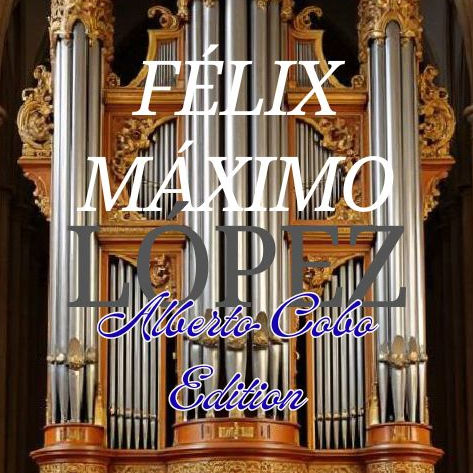W. Krumbach vs. Alberto Cobo in López
- Cochuchi

- Sep 10
- 4 min read
Piece V from the "Pieces for the Organ"
[called by some the Sonata in G minor for organ]
by Félix Máximo López
Source: National Library BNE M/769
Krumbach's edition appears to have been the most widely performed version of this piece or sonata to date.
Watch a video with W. Krumbach's score:
Watch video with my score:
The edition of the score is available for purchase at this link


1993. It was published in Bergamo by Edizioni Carrara (Organistica magazine, “Silva Iberica,” pp. 40–43; listed as “revisione di W. Krumbach”). Source: Conservatorio di Como
The tempo/tempo or movement indication: “Andantino” for the right hand and “Allegreto” for the left hand in the manuscript of this organ piece strikes me as very peculiar. I'd never seen that before, since “Allegreto” cannot modify “Andantino.” In fact, they are two very similar terms, although perhaps “Allegreto” is somewhat faster. My interpretation is that the repetitions of the two parts of the piece are in “Allegreto” tempo, that is, with a faster pulse.
- Krumbach indicates only “Allegretto” as the tempo of the piece, and what López indicated above, “Andantino,” directly avoids and overrides it.
- Krumbach wrote an F# in the fourth eighth note of the left hand of measure 8, when López clearly left a D a third lower. This isn't very relevant in listening, but it reinforces the G minor dominant harmony.
- In measure 9, Krumbach doesn't include in his edition of this Sonata or Piece the stems upwards from the B-flat in the left hand, which represent another voice until measure 13.
- He doesn't clarify in measure 11 that López did write a B-flat, but this is now represented in parentheses as it is a precautionary alteration.
- In measure 12, López clearly writes a natural note in the F, while Krumbach, however, adds a sharp (#), which, yes, sounds more resounding in classical harmony. However, López is in a transition between ecclesiastical modes and classicism, so he tends to play with the leading note.
- In measures 19 and 21, López writes two B notes in the left hand, while Krumbach transforms the second B into a D (this turn is most common in pre-classical music, as Mozart would do, but not in Spanish music). As in measures 18, 19, 20, 21, and 25, López places the sixteenth notes F in the left hand on the upper staff. These are also the same notes, but in López's case, the difference lies both in the aesthetics of the score, by avoiding additional lines, and in the inherent flight or movement.
- In bars 31 and 33, which are then repeated in bars 46 and 48, the mordent seems clearly not to be the typical one that would have resulted, due to the note being lower than the real one, but it is evident that when separated from the staff it should be the higher note, that is, A (since until now I have never found that in mordents of a single note they are not of contiguous tones).
- In measure 43, Krumbach indicates in brackets that the right-hand C in the eighth note could have been complemented by the reinforcement of the A and F, creating a chord similar to the one he did in measure 13. But López writes only the C, as he almost always does, in a kind of slight variation on the above to avoid monotony. He does the same in measure 89, but adding, in this case, the F# and D in brackets.
- In measure 52, Krumbach resolved the downward turn at the end of the phrase in the right hand in the third eighth note into a B, while López wrote a D, which is entirely logical because repeating the B along with another B in the bass is too repetitive. Any composer worth his salt knows this. It's like language: it loses interest.
- In bars 62 and 64, Krumbach thought it logical to repeat the previous sharp of the F, even though the manuscript doesn't say anything, and given that the sharp does appear in the left hand in the second half of the bar. But, the most obvious thing to think is that if he was interested in writing it in the left hand, why wouldn't he write it again in the right? But since in bar 84 we find a very similar case in which the final B is repeated exactly with the B at the beginning of the next bar, plus then that same B appears at the same height in the fourth flatted sixteenth note, this is quite clear proof that López or the copyist of this piece had some conventions to not repeat the accidental so often even if the meter changed. To solve this unknown, in this case of bars 62 and 64, in my edition it appears exactly as it is written in the manuscript with two explanatory signs, and each performer can judge whether they should play a sharp or a natural. While in measure 84 I do grant the natural note to the initial B for two reasons: the sound would be quite forced if it were flat, and because in the fourth sixteenth note the flat suddenly appears marked.
- Finally, in the final measure, 105, López ends in the right hand with Bb-D-Bb in successive eighth notes, while Krumbach wrote: G-D-G. Which are all notes corresponding to the G minor chord. Theory says that the sensitive F# of the previous measure should necessarily resolve to G to end, but López does not show it that way; when played, the G sounds, but it is only the bass.






Comments